Finance Case Study: Holding Period Returns and Financial Ratios
VerifiedAdded on 2023/03/20
|9
|1575
|22
Case Study
AI Summary
This finance case study analyzes the financial performance of Domino's Pizza Enterprises (DPE) and Retail Food Group (RFG). It calculates holding period returns for both companies from 2013 to 2018, comparing their shareholder returns and evaluating profitability, efficiency, liquidity, and solvency using financial ratios. The study also includes a break-even analysis and profitability assessment for a cupcake business, calculating contribution margins, break-even points, and net present value (NPV) for an investment scenario. The analysis concludes with investment recommendations and a discussion of associated risks. The case study demonstrates the application of financial concepts and decision-making.
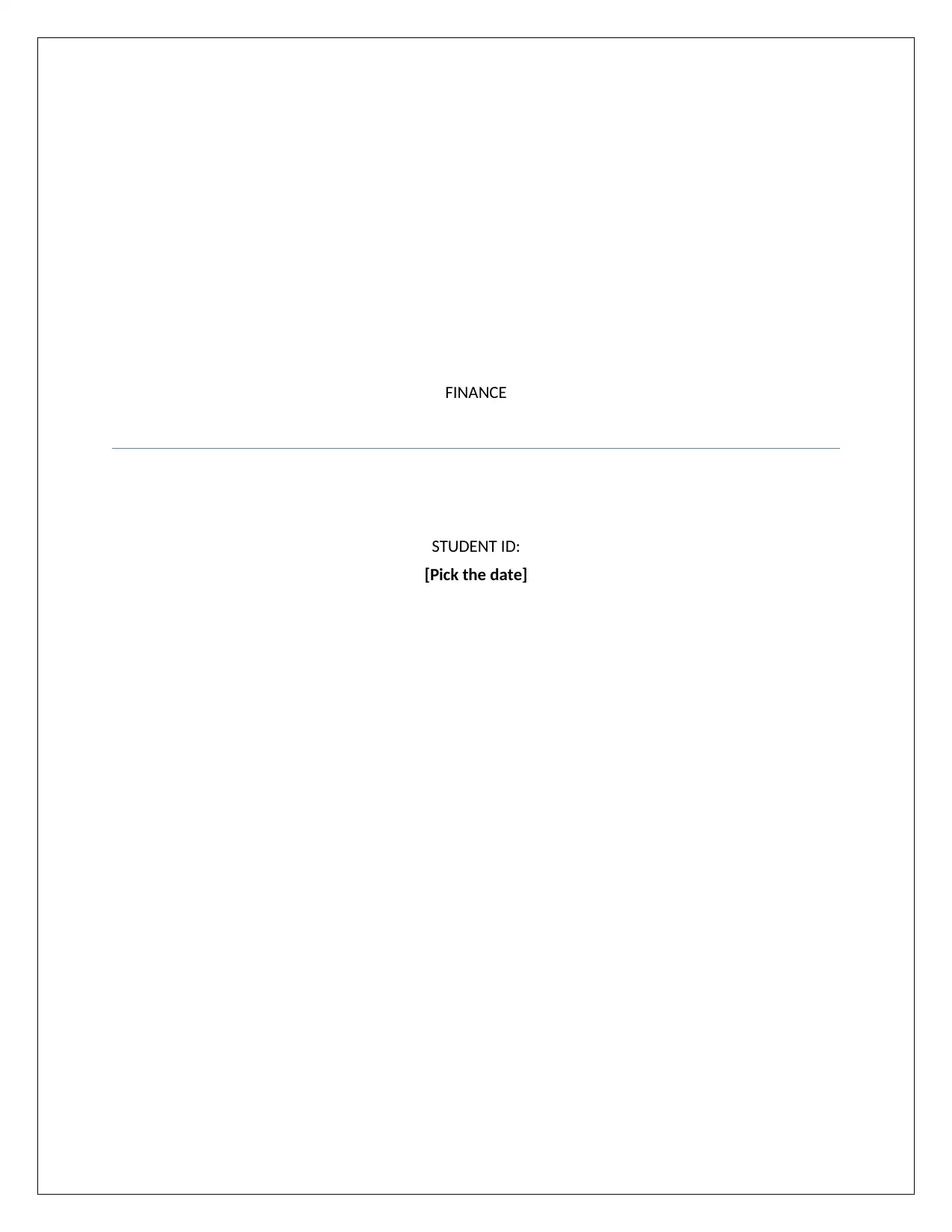
FINANCE
STUDENT ID:
[Pick the date]
STUDENT ID:
[Pick the date]
Paraphrase This Document
Need a fresh take? Get an instant paraphrase of this document with our AI Paraphraser
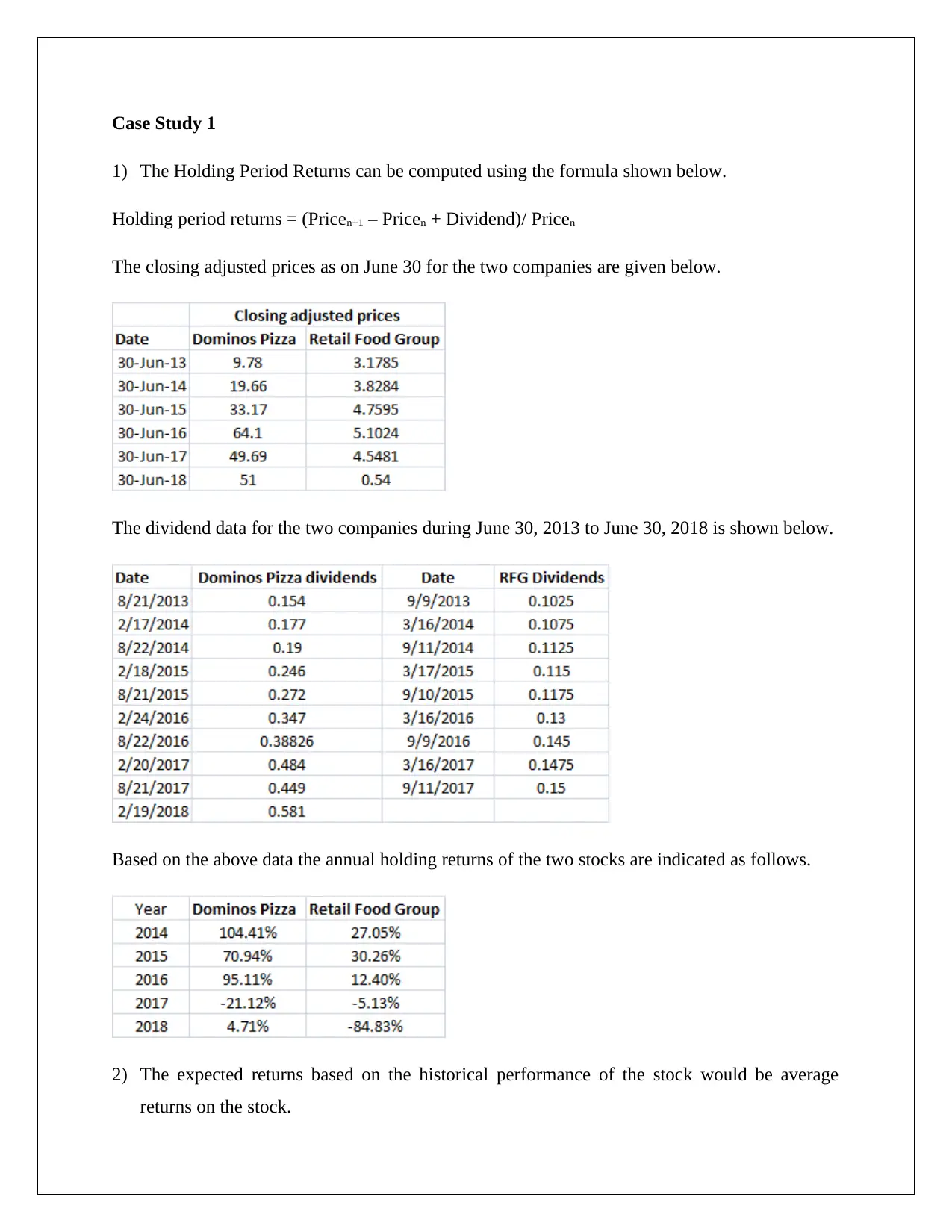
Case Study 1
1) The Holding Period Returns can be computed using the formula shown below.
Holding period returns = (Pricen+1 – Pricen + Dividend)/ Pricen
The closing adjusted prices as on June 30 for the two companies are given below.
The dividend data for the two companies during June 30, 2013 to June 30, 2018 is shown below.
Based on the above data the annual holding returns of the two stocks are indicated as follows.
2) The expected returns based on the historical performance of the stock would be average
returns on the stock.
1) The Holding Period Returns can be computed using the formula shown below.
Holding period returns = (Pricen+1 – Pricen + Dividend)/ Pricen
The closing adjusted prices as on June 30 for the two companies are given below.
The dividend data for the two companies during June 30, 2013 to June 30, 2018 is shown below.
Based on the above data the annual holding returns of the two stocks are indicated as follows.
2) The expected returns based on the historical performance of the stock would be average
returns on the stock.
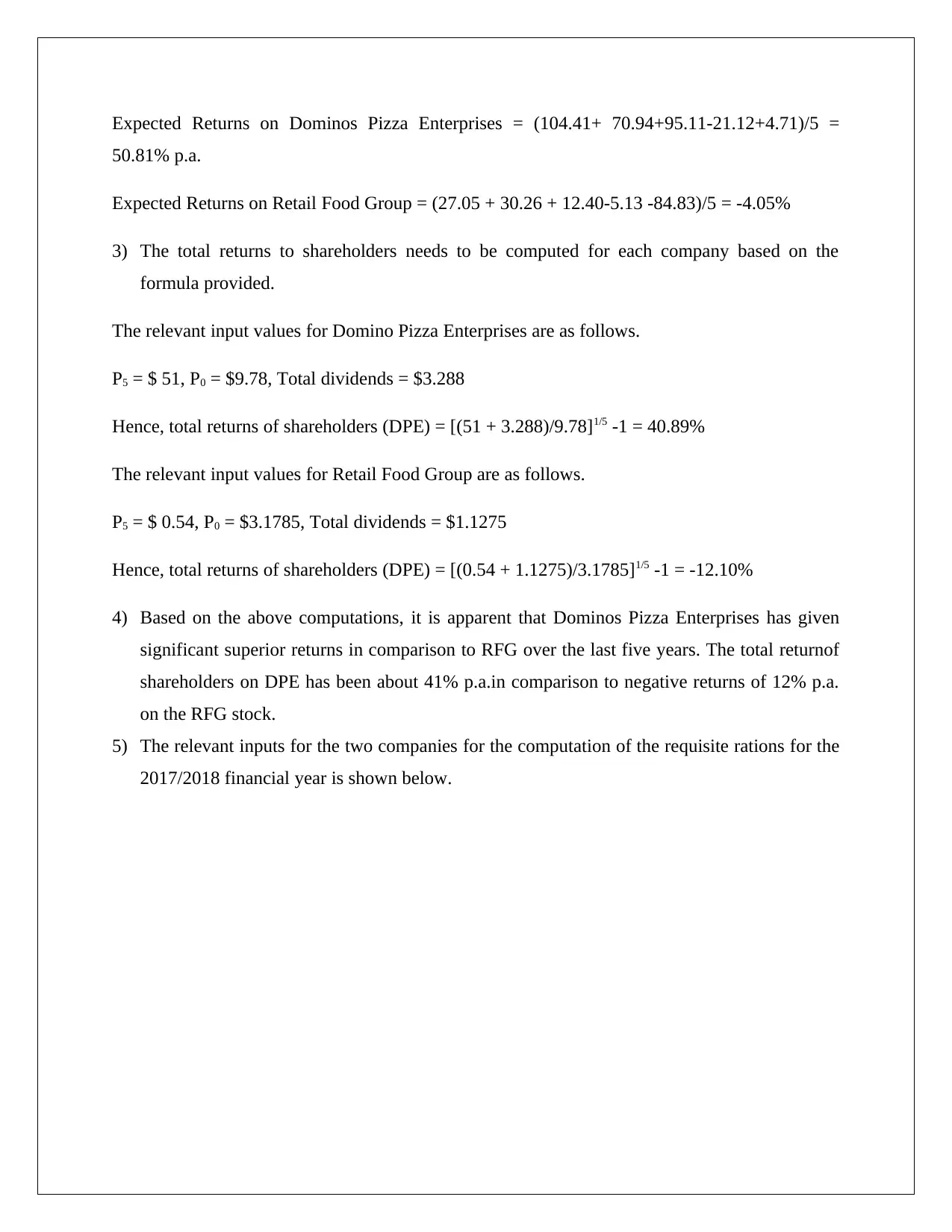
Expected Returns on Dominos Pizza Enterprises = (104.41+ 70.94+95.11-21.12+4.71)/5 =
50.81% p.a.
Expected Returns on Retail Food Group = (27.05 + 30.26 + 12.40-5.13 -84.83)/5 = -4.05%
3) The total returns to shareholders needs to be computed for each company based on the
formula provided.
The relevant input values for Domino Pizza Enterprises are as follows.
P5 = $ 51, P0 = $9.78, Total dividends = $3.288
Hence, total returns of shareholders (DPE) = [(51 + 3.288)/9.78]1/5 -1 = 40.89%
The relevant input values for Retail Food Group are as follows.
P5 = $ 0.54, P0 = $3.1785, Total dividends = $1.1275
Hence, total returns of shareholders (DPE) = [(0.54 + 1.1275)/3.1785]1/5 -1 = -12.10%
4) Based on the above computations, it is apparent that Dominos Pizza Enterprises has given
significant superior returns in comparison to RFG over the last five years. The total returnof
shareholders on DPE has been about 41% p.a.in comparison to negative returns of 12% p.a.
on the RFG stock.
5) The relevant inputs for the two companies for the computation of the requisite rations for the
2017/2018 financial year is shown below.
50.81% p.a.
Expected Returns on Retail Food Group = (27.05 + 30.26 + 12.40-5.13 -84.83)/5 = -4.05%
3) The total returns to shareholders needs to be computed for each company based on the
formula provided.
The relevant input values for Domino Pizza Enterprises are as follows.
P5 = $ 51, P0 = $9.78, Total dividends = $3.288
Hence, total returns of shareholders (DPE) = [(51 + 3.288)/9.78]1/5 -1 = 40.89%
The relevant input values for Retail Food Group are as follows.
P5 = $ 0.54, P0 = $3.1785, Total dividends = $1.1275
Hence, total returns of shareholders (DPE) = [(0.54 + 1.1275)/3.1785]1/5 -1 = -12.10%
4) Based on the above computations, it is apparent that Dominos Pizza Enterprises has given
significant superior returns in comparison to RFG over the last five years. The total returnof
shareholders on DPE has been about 41% p.a.in comparison to negative returns of 12% p.a.
on the RFG stock.
5) The relevant inputs for the two companies for the computation of the requisite rations for the
2017/2018 financial year is shown below.
⊘ This is a preview!⊘
Do you want full access?
Subscribe today to unlock all pages.

Trusted by 1+ million students worldwide
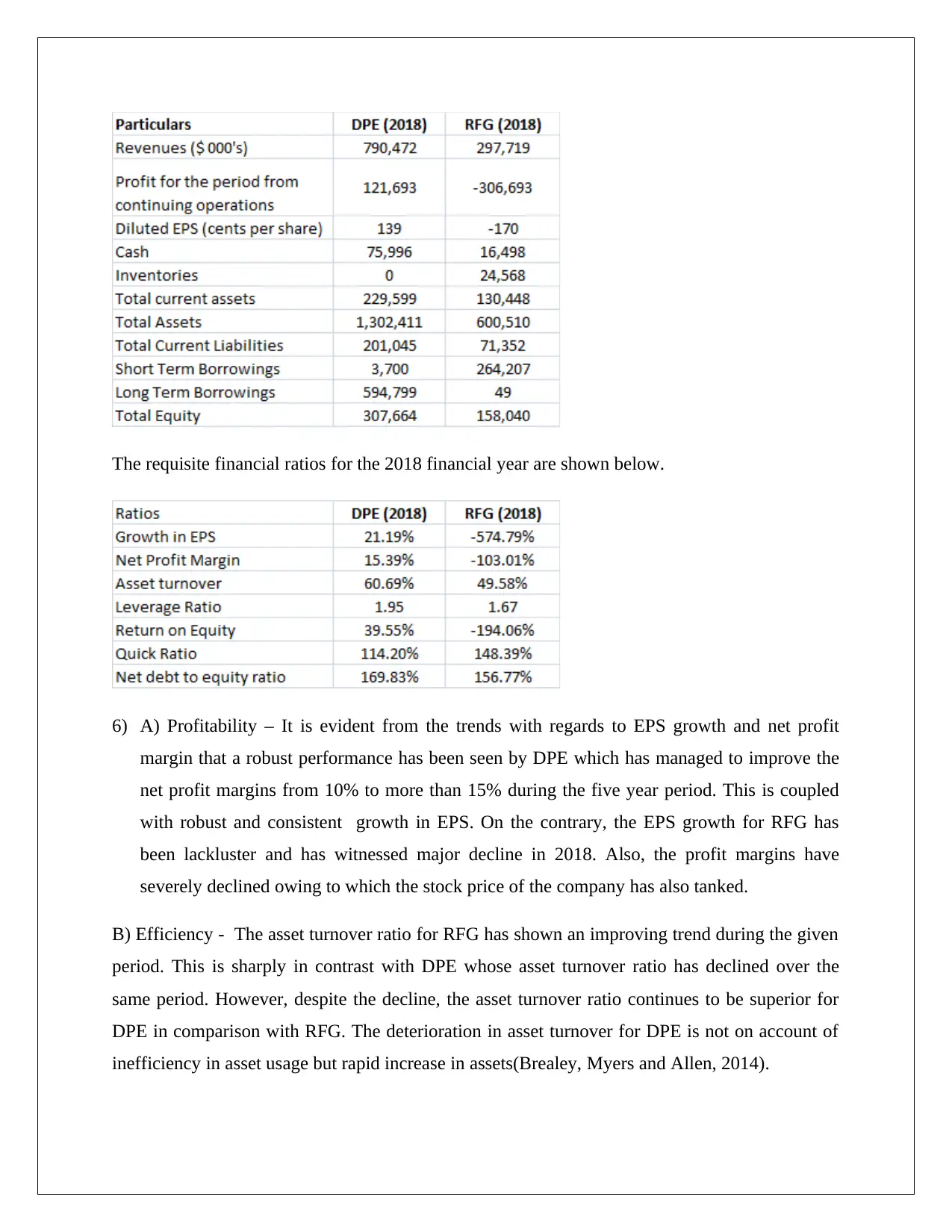
The requisite financial ratios for the 2018 financial year are shown below.
6) A) Profitability – It is evident from the trends with regards to EPS growth and net profit
margin that a robust performance has been seen by DPE which has managed to improve the
net profit margins from 10% to more than 15% during the five year period. This is coupled
with robust and consistent growth in EPS. On the contrary, the EPS growth for RFG has
been lackluster and has witnessed major decline in 2018. Also, the profit margins have
severely declined owing to which the stock price of the company has also tanked.
B) Efficiency - The asset turnover ratio for RFG has shown an improving trend during the given
period. This is sharply in contrast with DPE whose asset turnover ratio has declined over the
same period. However, despite the decline, the asset turnover ratio continues to be superior for
DPE in comparison with RFG. The deterioration in asset turnover for DPE is not on account of
inefficiency in asset usage but rapid increase in assets(Brealey, Myers and Allen, 2014).
6) A) Profitability – It is evident from the trends with regards to EPS growth and net profit
margin that a robust performance has been seen by DPE which has managed to improve the
net profit margins from 10% to more than 15% during the five year period. This is coupled
with robust and consistent growth in EPS. On the contrary, the EPS growth for RFG has
been lackluster and has witnessed major decline in 2018. Also, the profit margins have
severely declined owing to which the stock price of the company has also tanked.
B) Efficiency - The asset turnover ratio for RFG has shown an improving trend during the given
period. This is sharply in contrast with DPE whose asset turnover ratio has declined over the
same period. However, despite the decline, the asset turnover ratio continues to be superior for
DPE in comparison with RFG. The deterioration in asset turnover for DPE is not on account of
inefficiency in asset usage but rapid increase in assets(Brealey, Myers and Allen, 2014).
Paraphrase This Document
Need a fresh take? Get an instant paraphrase of this document with our AI Paraphraser
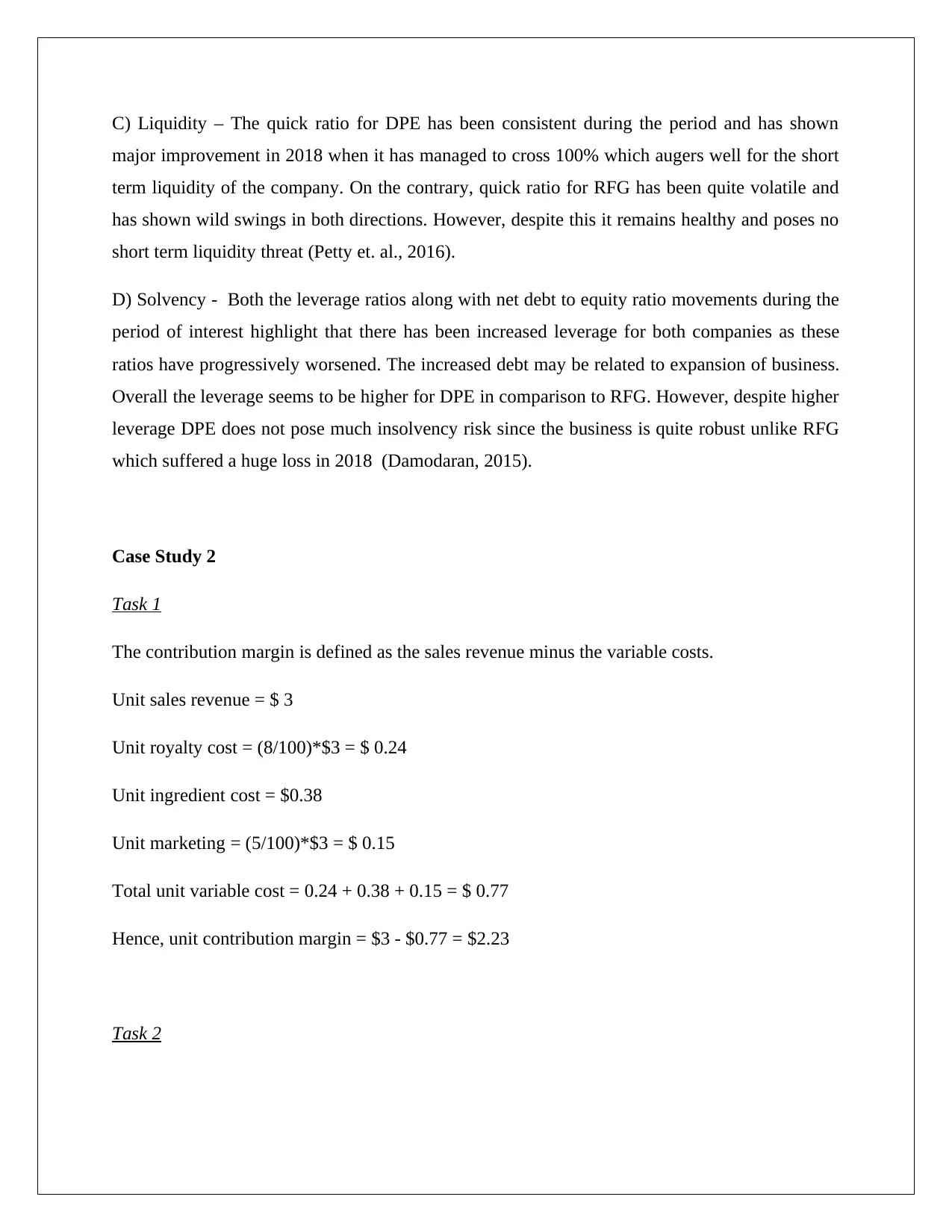
C) Liquidity – The quick ratio for DPE has been consistent during the period and has shown
major improvement in 2018 when it has managed to cross 100% which augers well for the short
term liquidity of the company. On the contrary, quick ratio for RFG has been quite volatile and
has shown wild swings in both directions. However, despite this it remains healthy and poses no
short term liquidity threat (Petty et. al., 2016).
D) Solvency - Both the leverage ratios along with net debt to equity ratio movements during the
period of interest highlight that there has been increased leverage for both companies as these
ratios have progressively worsened. The increased debt may be related to expansion of business.
Overall the leverage seems to be higher for DPE in comparison to RFG. However, despite higher
leverage DPE does not pose much insolvency risk since the business is quite robust unlike RFG
which suffered a huge loss in 2018 (Damodaran, 2015).
Case Study 2
Task 1
The contribution margin is defined as the sales revenue minus the variable costs.
Unit sales revenue = $ 3
Unit royalty cost = (8/100)*$3 = $ 0.24
Unit ingredient cost = $0.38
Unit marketing = (5/100)*$3 = $ 0.15
Total unit variable cost = 0.24 + 0.38 + 0.15 = $ 0.77
Hence, unit contribution margin = $3 - $0.77 = $2.23
Task 2
major improvement in 2018 when it has managed to cross 100% which augers well for the short
term liquidity of the company. On the contrary, quick ratio for RFG has been quite volatile and
has shown wild swings in both directions. However, despite this it remains healthy and poses no
short term liquidity threat (Petty et. al., 2016).
D) Solvency - Both the leverage ratios along with net debt to equity ratio movements during the
period of interest highlight that there has been increased leverage for both companies as these
ratios have progressively worsened. The increased debt may be related to expansion of business.
Overall the leverage seems to be higher for DPE in comparison to RFG. However, despite higher
leverage DPE does not pose much insolvency risk since the business is quite robust unlike RFG
which suffered a huge loss in 2018 (Damodaran, 2015).
Case Study 2
Task 1
The contribution margin is defined as the sales revenue minus the variable costs.
Unit sales revenue = $ 3
Unit royalty cost = (8/100)*$3 = $ 0.24
Unit ingredient cost = $0.38
Unit marketing = (5/100)*$3 = $ 0.15
Total unit variable cost = 0.24 + 0.38 + 0.15 = $ 0.77
Hence, unit contribution margin = $3 - $0.77 = $2.23
Task 2
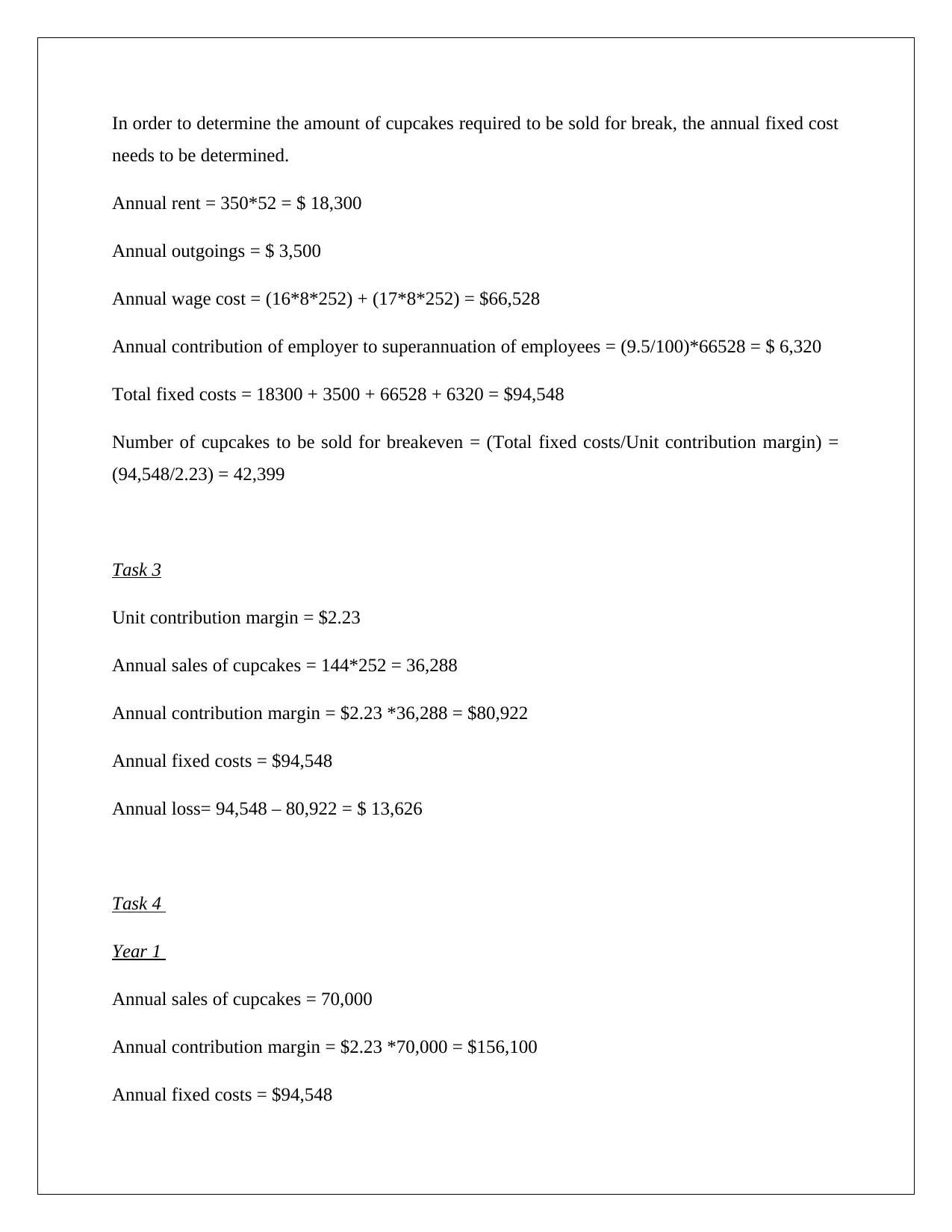
In order to determine the amount of cupcakes required to be sold for break, the annual fixed cost
needs to be determined.
Annual rent = 350*52 = $ 18,300
Annual outgoings = $ 3,500
Annual wage cost = (16*8*252) + (17*8*252) = $66,528
Annual contribution of employer to superannuation of employees = (9.5/100)*66528 = $ 6,320
Total fixed costs = 18300 + 3500 + 66528 + 6320 = $94,548
Number of cupcakes to be sold for breakeven = (Total fixed costs/Unit contribution margin) =
(94,548/2.23) = 42,399
Task 3
Unit contribution margin = $2.23
Annual sales of cupcakes = 144*252 = 36,288
Annual contribution margin = $2.23 *36,288 = $80,922
Annual fixed costs = $94,548
Annual loss= 94,548 – 80,922 = $ 13,626
Task 4
Year 1
Annual sales of cupcakes = 70,000
Annual contribution margin = $2.23 *70,000 = $156,100
Annual fixed costs = $94,548
needs to be determined.
Annual rent = 350*52 = $ 18,300
Annual outgoings = $ 3,500
Annual wage cost = (16*8*252) + (17*8*252) = $66,528
Annual contribution of employer to superannuation of employees = (9.5/100)*66528 = $ 6,320
Total fixed costs = 18300 + 3500 + 66528 + 6320 = $94,548
Number of cupcakes to be sold for breakeven = (Total fixed costs/Unit contribution margin) =
(94,548/2.23) = 42,399
Task 3
Unit contribution margin = $2.23
Annual sales of cupcakes = 144*252 = 36,288
Annual contribution margin = $2.23 *36,288 = $80,922
Annual fixed costs = $94,548
Annual loss= 94,548 – 80,922 = $ 13,626
Task 4
Year 1
Annual sales of cupcakes = 70,000
Annual contribution margin = $2.23 *70,000 = $156,100
Annual fixed costs = $94,548
⊘ This is a preview!⊘
Do you want full access?
Subscribe today to unlock all pages.

Trusted by 1+ million students worldwide

Annual profit before tax = $156,100 - $94,548 = $ 61,552
Net profit after tax = $ 61,552(1-0.3) = $ 43,086
Year 2
Annual sales of cupcakes = 80,000
Annual contribution margin = $2.23 *80,000 = $178,400
Annual fixed costs = $94,548
Annual profit = $178,400 - $94,548 = $ 83,852
Net profit after tax = $ 83,852(1-0.3) = $ 58,696
Year 3
Annual sales of cupcakes = 90,000
Annual contribution margin = $2.23 *90,000 = $200,700
Annual fixed costs = $94,548
Annual profit = $200,700 - $94,548 = $ 106,152
Net profit after tax = $106,152(1-0.3) = $ 74,306
Task 5
The net cashflows for various year is summarized below.
Year 0 = -$ 200,000 (Initial investment)
Year 1 = $ 43,086
Year 2 = $ 58,696
Year 3 = Annual net profit + Sale proceeds = $ 74,306 + $ 150,000 = $224,306
Net profit after tax = $ 61,552(1-0.3) = $ 43,086
Year 2
Annual sales of cupcakes = 80,000
Annual contribution margin = $2.23 *80,000 = $178,400
Annual fixed costs = $94,548
Annual profit = $178,400 - $94,548 = $ 83,852
Net profit after tax = $ 83,852(1-0.3) = $ 58,696
Year 3
Annual sales of cupcakes = 90,000
Annual contribution margin = $2.23 *90,000 = $200,700
Annual fixed costs = $94,548
Annual profit = $200,700 - $94,548 = $ 106,152
Net profit after tax = $106,152(1-0.3) = $ 74,306
Task 5
The net cashflows for various year is summarized below.
Year 0 = -$ 200,000 (Initial investment)
Year 1 = $ 43,086
Year 2 = $ 58,696
Year 3 = Annual net profit + Sale proceeds = $ 74,306 + $ 150,000 = $224,306
Paraphrase This Document
Need a fresh take? Get an instant paraphrase of this document with our AI Paraphraser
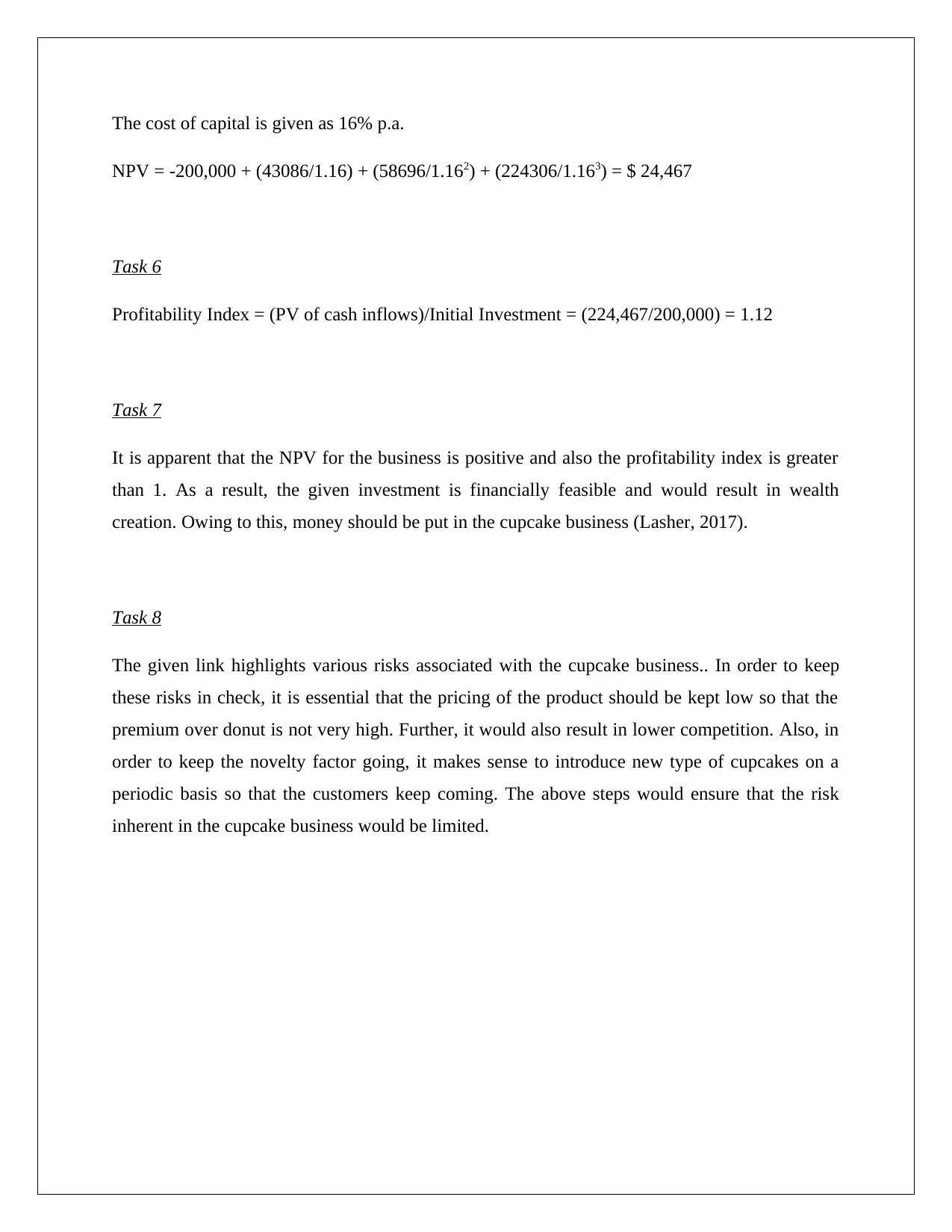
The cost of capital is given as 16% p.a.
NPV = -200,000 + (43086/1.16) + (58696/1.162) + (224306/1.163) = $ 24,467
Task 6
Profitability Index = (PV of cash inflows)/Initial Investment = (224,467/200,000) = 1.12
Task 7
It is apparent that the NPV for the business is positive and also the profitability index is greater
than 1. As a result, the given investment is financially feasible and would result in wealth
creation. Owing to this, money should be put in the cupcake business (Lasher, 2017).
Task 8
The given link highlights various risks associated with the cupcake business.. In order to keep
these risks in check, it is essential that the pricing of the product should be kept low so that the
premium over donut is not very high. Further, it would also result in lower competition. Also, in
order to keep the novelty factor going, it makes sense to introduce new type of cupcakes on a
periodic basis so that the customers keep coming. The above steps would ensure that the risk
inherent in the cupcake business would be limited.
NPV = -200,000 + (43086/1.16) + (58696/1.162) + (224306/1.163) = $ 24,467
Task 6
Profitability Index = (PV of cash inflows)/Initial Investment = (224,467/200,000) = 1.12
Task 7
It is apparent that the NPV for the business is positive and also the profitability index is greater
than 1. As a result, the given investment is financially feasible and would result in wealth
creation. Owing to this, money should be put in the cupcake business (Lasher, 2017).
Task 8
The given link highlights various risks associated with the cupcake business.. In order to keep
these risks in check, it is essential that the pricing of the product should be kept low so that the
premium over donut is not very high. Further, it would also result in lower competition. Also, in
order to keep the novelty factor going, it makes sense to introduce new type of cupcakes on a
periodic basis so that the customers keep coming. The above steps would ensure that the risk
inherent in the cupcake business would be limited.
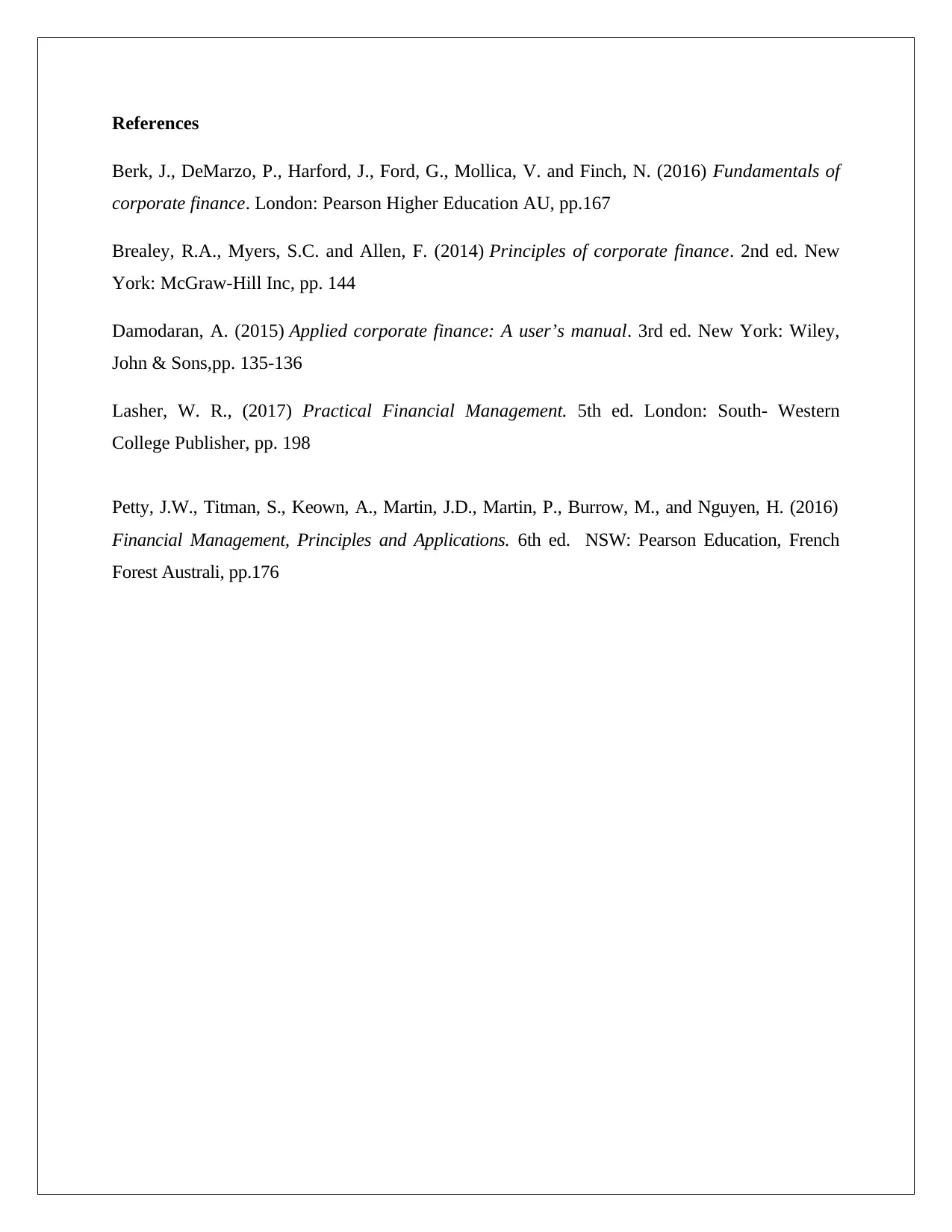
References
Berk, J., DeMarzo, P., Harford, J., Ford, G., Mollica, V. and Finch, N. (2016) Fundamentals of
corporate finance. London: Pearson Higher Education AU, pp.167
Brealey, R.A., Myers, S.C. and Allen, F. (2014) Principles of corporate finance. 2nd ed. New
York: McGraw-Hill Inc, pp. 144
Damodaran, A. (2015) Applied corporate finance: A user’s manual. 3rd ed. New York: Wiley,
John & Sons,pp. 135-136
Lasher, W. R., (2017) Practical Financial Management. 5th ed. London: South- Western
College Publisher, pp. 198
Petty, J.W., Titman, S., Keown, A., Martin, J.D., Martin, P., Burrow, M., and Nguyen, H. (2016)
Financial Management, Principles and Applications. 6th ed. NSW: Pearson Education, French
Forest Australi, pp.176
Berk, J., DeMarzo, P., Harford, J., Ford, G., Mollica, V. and Finch, N. (2016) Fundamentals of
corporate finance. London: Pearson Higher Education AU, pp.167
Brealey, R.A., Myers, S.C. and Allen, F. (2014) Principles of corporate finance. 2nd ed. New
York: McGraw-Hill Inc, pp. 144
Damodaran, A. (2015) Applied corporate finance: A user’s manual. 3rd ed. New York: Wiley,
John & Sons,pp. 135-136
Lasher, W. R., (2017) Practical Financial Management. 5th ed. London: South- Western
College Publisher, pp. 198
Petty, J.W., Titman, S., Keown, A., Martin, J.D., Martin, P., Burrow, M., and Nguyen, H. (2016)
Financial Management, Principles and Applications. 6th ed. NSW: Pearson Education, French
Forest Australi, pp.176
⊘ This is a preview!⊘
Do you want full access?
Subscribe today to unlock all pages.

Trusted by 1+ million students worldwide
1 out of 9
Related Documents
Your All-in-One AI-Powered Toolkit for Academic Success.
+13062052269
info@desklib.com
Available 24*7 on WhatsApp / Email
![[object Object]](/_next/static/media/star-bottom.7253800d.svg)
Unlock your academic potential
Copyright © 2020–2025 A2Z Services. All Rights Reserved. Developed and managed by ZUCOL.





